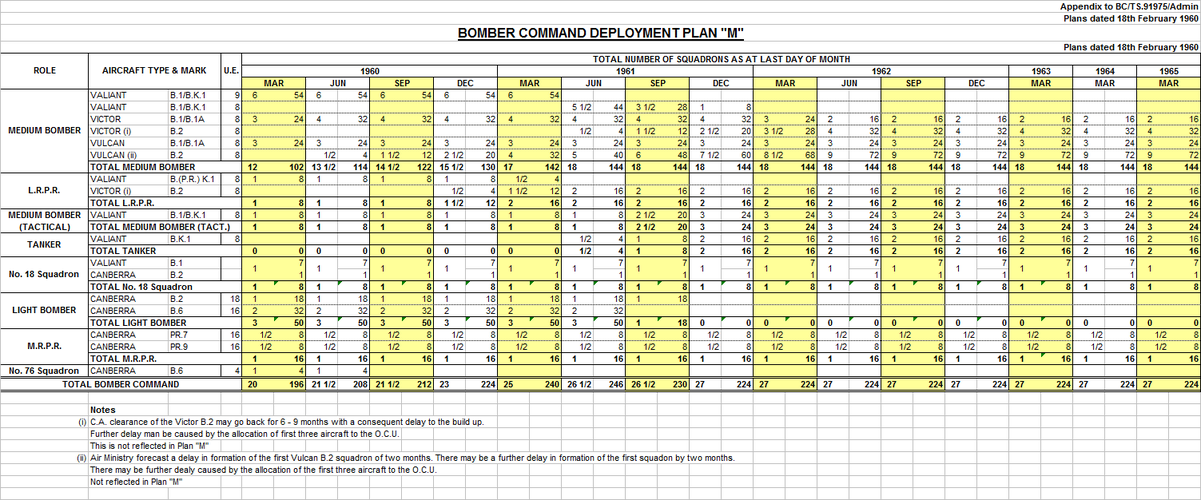NOMISYRRUC
ACCESS: Top Secret
- Joined
- 28 September 2008
- Messages
- 2,311
- Reaction score
- 3,705
This is Bomber Command's portion of Plan M which covers the period from 31st March 1960 to 31st March 1965.
I compiled the spreadsheet from a document dated 18th February 1960 that was provided by @yellowaster.

The salient differences between this plan and the September 1957 version of Plan L in Post 21 are:
The other reason was that a squadron of 8 Valiants was transferred from the Medium Bomber Force to the Tactical Bomber Force at the beginning of 1960.
Both plans had peak strengths of 32 Victor B.1s in 4 squadrons and 24 Vulcan B.1s in 3 squadrons. However, this would reduce to:
Plan L had 71 Valiants in 9 squadrons at 31/03/60 and Plan M had 77 aircraft in 9 squadrons at 31/03/60. The reason for the discrepancy was that that Plan L had 56 Valiant medium bombers in 7 squadrons of 8 aircraft while Plan M had 54 Valiant medium bombers in 6 squadrons of 9 aircraft and 8 Valiant tactical bombers in one squadron.
I compiled the spreadsheet from a document dated 18th February 1960 that was provided by @yellowaster.

The salient differences between this plan and the September 1957 version of Plan L in Post 21 are:
- There were 247 aircraft in 26 squadrons at 31/03/60 in Plan L. This included 132 Medium Bombers in 16½ squadrons and 12 L.R.P.R. aircraft one-and-a-half squadrons.
- There were 196 aircraft in 20 squadrons at 31/03/60 in Plan M. This included 102 Medium Bombers in 12 squadrons and 8 L.R.P.R. aircraft in one squadron.
The other reason was that a squadron of 8 Valiants was transferred from the Medium Bomber Force to the Tactical Bomber Force at the beginning of 1960.
- There were to be 263 aircraft in 28 squadrons from 30/09/60 to 31/03/63 under Plan L.
- There were to be 224 aircraft in 27 squadrons from 31/12/61 to 31/03/65 under Plan M.
Both plans had peak strengths of 32 Victor B.1s in 4 squadrons and 24 Vulcan B.1s in 3 squadrons. However, this would reduce to:
- 24 Victor B.1s in 3 squadrons and 16 Vulcan B.1s in 2 squadrons in Plan L.
- 16 Victor B.1s in 2 squadrons and 24 Vulcan B.1s in 3 squadrons in Plan M.
Plan L had 71 Valiants in 9 squadrons at 31/03/60 and Plan M had 77 aircraft in 9 squadrons at 31/03/60. The reason for the discrepancy was that that Plan L had 56 Valiant medium bombers in 7 squadrons of 8 aircraft while Plan M had 54 Valiant medium bombers in 6 squadrons of 9 aircraft and 8 Valiant tactical bombers in one squadron.
- Under Plan L the Valiants were to be reduced from 71 aircraft in 9 squadrons at 31/03/60 to 7 aircraft in one squadron at 31/03/62.
- Under Plan M the Valiants were to be reduced from 77 aircraft in 9 squadrons at 31/12/60 to 47 aircraft in 6 squadrons in at 31/03/62.
- 16 aircraft in 2 squadrons were retained as Tankers and;
- 24 aircraft in 3 squadrons were retained as Tactical Bombers .
Last edited:


